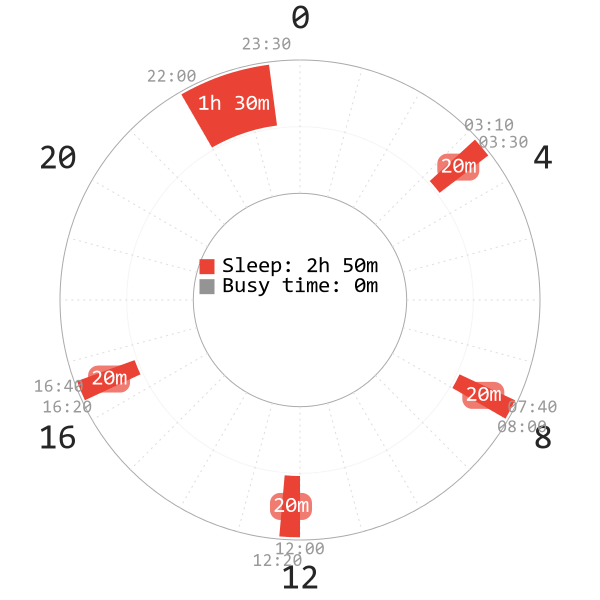
Everyman 4, or E4, is the third Everyman schedule in the Everyman polyphasic series. The structure of the schedule is very short and scattered. The longest sleep block is only 90m, so E4 now has the shortest core length on all Everyman schedules. It is one of the final steps (the other being E5) before the transition to Uberman. It consists of 4 naps each day, and each nap lasts for 20m.
Content
- History
- Mechanism
- Adaptation
- Difficulty
- Alternate Variants
- Lifestyle Considerations
History
As part of the “Formula” by Puredoxyk, Everyman 4 used to be called “E1.5” to represent the core duration. With the shortest core duration of all Everyman schedules, E4 is now the most difficult (bar E5).
In the same vein as E5, there should be 4-5 naps on an Everyman schedule with a 1.5h core. Despite the formula, Puredoxyk never attempted to adapt to E4. There are 5 sleep blocks each day on this Everyman schedule.
Mechanism
Everyman 4 keeps the same premises as other Everyman schedules, but under much harsher conditions. The core further reduces to the minimum cycle length from E3 with the addition of the fourth nap.
Core
- The core sleep, the small “nucleus” of the schedule, serves to provide a hopefully sufficient amount of SWS daily.
- To ensure the most amount of SWS, the core sleep is now at the heart of SWS peak, ideally starting between 9 and 10 PM. The fourth nap’s purpose is to balance the long wake gap between the end of the core and the nap around sunrise hours. In a way, E4 is basically DC3 without the second core, as DC3’s second core is also placed around the same time as E4’s first nap.
- The sleep cycle during E4 core compresses potentially to as short as 60 minutes, which seems to be due to an extremely short core and a high frequency of naps. That means its core duration is actually one and a half cycles; this is a danger for mid-cycle SWS wakes until the brain adapts by placing light sleep at the trained wake time.
Naps
- The naps, as usual, will provide REM sleep and traces of light sleep. However, what works on its less extreme counterparts, E2 and E3, does not work the same on E4. The core sleep is simply not long enough to sustain a 90m SWS requirement each day, taking into account of transitional light sleep; thus, at least one nap will contain SWS. SWS’ homeostatic pressure can creep into any naps, especially the last nap on the schedule.
- The overall schedule looks equidistant; however, there is a longer wake gap from the last nap to the core. There is approximately 4 hours of wake gap between each nap, which ideally fits into the BRAC concept (~4h rhythm). After taking all the naps, one can expect an easier time to stay awake in the afternoon and evening hours.
- The naps also take advantage of the common circadian spots for sleep. The first two are during graveyard hours, which coincide with monophasic sleep time. Meanwhile, the midday nap resembles a nap on a biphasic schedule (noon circadian nadir); the last nap is around ~4-5 PM, when core body temperature reaches the maximum value. This is suitable for short sleep durations to ease waking up.
Adaptation
Cold turkey
This is the most common method for success. So far, it has accounted for 100% of successful adaptations. With the gruesome adaptation process, this method can immediately tell if an adaptation is possible. If the adaptation can be complete, then this route may also take the shortest amount of time.
Gradual Adaptation
Though it is possible to transition to E4 as a gradual adaptation from E3 or E2, so far this has reported no success. It is likely that adaptation to E3 is already overbearing at that point. On top of that is another immediate transition to E4 which is below the minimum sleep threshold.
E4 is also an option to fall back on if Uberman fails, but no one has been able to pull this off, either. The overall time it takes to adapt to E4 on this method would be very time-consuming.
Difficulty
Adaptation to Everyman 4 is severely more difficult than to E3, because the removal of 1 core cycle makes it impossible to preserve all SWS baseline. Mostly because of E4’s incredible difficulty, successful adaptations are very rare up to date. However, the extended version is milder, and may be more hospitable for adaptability.
When adaptation first begins, as usual sleepers may not fall asleep in some or all of the naps. However, as sleep debt quickly accumulates, it will be easy to do so; Stage 3 is bound to arrive in a matter of days. Sleep deprivation will continually build up rather than getting relieved by the humble amount of total sleep. An extreme adaptation is then essential to reach the equilibrium of SWS and REM in all sleep blocks.
Any oversleeps greater than a rare 10m or so will be devastating to the adaptation process. It requires both strict circadian entrainment and severe homeostatic pressure. Average, normal individuals will incur chronic sleep deprivation if they attempt to adapt to E4.
Because of the near impossibility for an average polyphasic sleeper to adapt to this schedule, it is the case that inexperienced or non-mutant sleepers should not attempt this schedule.
Alternate Variants
Despite its unpopularity compared to E3 and Uberman, there has been limited success with E4 over the years. Below are the variants that have reported some success.
Longer Morning Wake Period

Up to date there has only been a success or two for this case. The concepts look similar to the default version, except for the nap placement.
- There is a slightly longer wake gap between the sunrise nap and the noon nap. This allows for more wake time in the morning to maintain an uninterrupted and longer work flow.
- The last nap is after regular work/school hours (which is usually around 5 PM) for convenience.
Regardless, due to the low total sleep, it is necessary to schedule the naps somewhat close together; a 20m nap on E4 will not fuel performance for as long as a 20m nap on E3 or E2 for that reason. Thus, it is not advisable to have more than ~5h wake gap between any naps (barring the last wake gap in the afternoon to the core) on regular E4 scheduling.
E4-extended
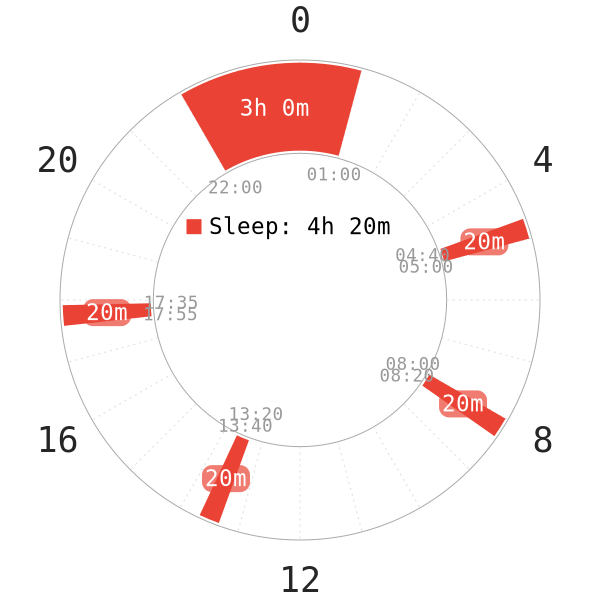
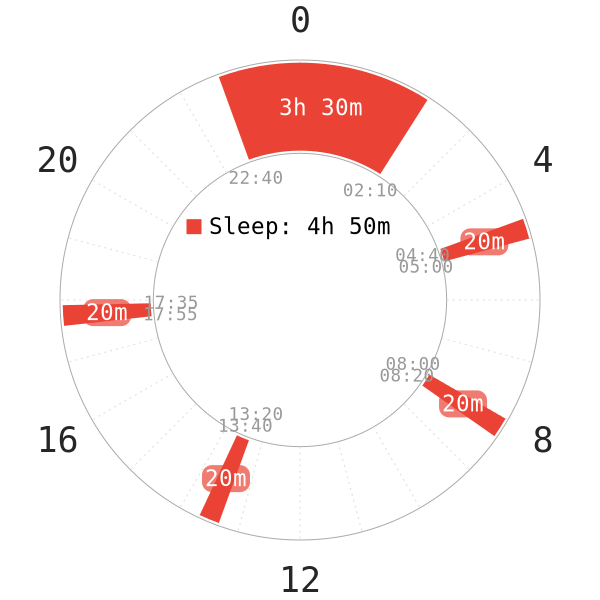
One polyphasic sleeper from the Discord community has successfully adapted to this variant. This Everyman 4 is basically E3 (3.5h core variant) with an extra nap.
- The extension of the core sleep creates a lot more space for SWS and REM. It also alleviates the pressure on the naps.
- Same as the regular E4 version, 2 naps center around night hours before the day starts. This would leave only 2 daytime naps.
- Alternatively, a 3h core is also viable, but it has only one success to date (sleep mutant). However, it is noteworthy that flexing a 3h core on an Everyman schedule is already highly difficult.
The extension of the core sleep and the high frequency of nighttime naps helps boost alertness more effectively during the worrisome graveyard hours. These hours is a common issue on almost, if not all, Everyman adaptations.
Despite an overwhelming adaptation, E4-extended may be somewhat milder than the default E3. This is largely owing to the frequency of sleep and the combined efforts of the core and the naps to protect the vital sleep stages.
With a reasonable amount of sleep from the extension, E4-extended may be sustainable long-term if the lifestyle allows for the clunky scheduling.
Lifestyle Considerations
With 5 sleep blocks per day, Everyman 4 offers an amazing amount of sleep reduction. However, sleeping 5 times per day may be a dull and demotivating concept. This is one of the reasons E4, whether extended or not, is far from as popular and well-known as E3.
Aside from the inflexibility after adaptation, virtually no exercise and/or consuming alcoholic beverages or drinks for an average sleeper, E4 actually has some saving graces from the more awkward E5. This may make it worth an attempt.
Less Extreme than Uberman
The extended variant shows that Everyman 4 remains a viable long-term option. Those who vacillate between Uberman’s extreme adaptation and E3 (whose sleep reduction does not suffice) can consider E4. The higher frequency of naps (at least on extended version) can also help prevent certain crashes.
Experienced sleepers can rely on their napping skills to learn to fall asleep and achieve SOREM in the nap(s) in the early adaptation stage.
Multiple Naps
This advantage teaches napping skills quickly, as sleep pressure racks up fast on E4. This is also an advantage that can push adaptation to a later stage faster than on schedules like E1; there are multiple opportunities per day to learn to fall asleep and wake up in just 20 minutes.
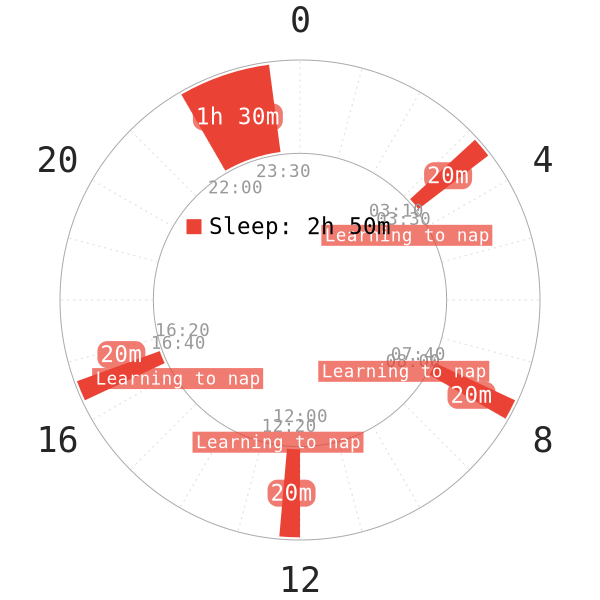
After this short learning period, one can recover on monophasic sleep and proceed to attempt other less extreme polyphasic schedules. They can still apply their learned napping skills from E4. In a way, Everyman 4 is a less extreme version of naptation.
Emergency Circumstances
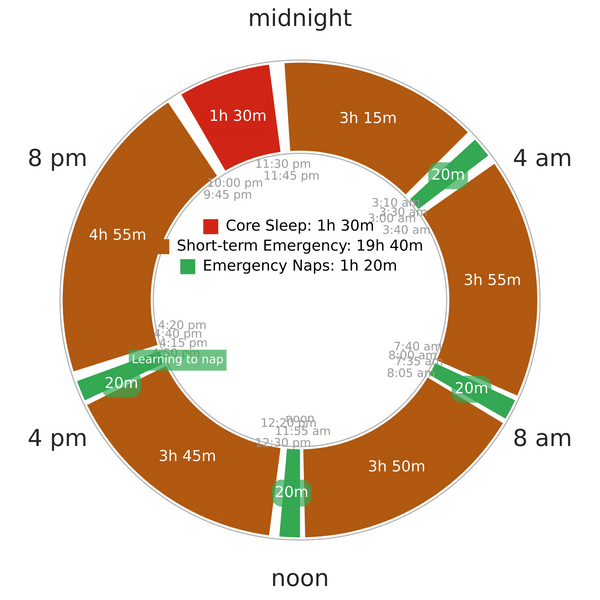
During periods that require less sleep for a brief period of time (e.g, ~1 week to ~1 month), the short naps and the core can act as temporary tanks to give some rest. Getting some rest in the meantime is more beneficial than pulling all-nighters. Individuals who can take advantage of E4 are the following:
- New parents
- Students on borrowed time
- Those who have been used to sleep deprivation to power through some days before recovering. The naps only last for 20m; coupled with E4’s total sleep, it can feel like “no sleep” or only “1.5h sleep” each day. It is necessary to optimize all waking hours for these urgent activities.
- Personal motivation and adrenaline will play a massive role to sustain productivity during these burst periods.
Two Daytime naps’ Viability

E4’s scheduling structure gives it the same vantage points as schedules with 2 daytime naps (e.g, DC2, E3). At face values, scheduling 2 daytime naps can be a problematic lifestyle; yet, it is possible if done right.
- The noon nap can be during a lunch break.
- The last nap can be after work.
- Breakfast can be after the second nap.
- Lunch can be after the noon nap.
- Dinner can be after the last nap, or ~2.5-3h before the core.
Thus, E4 can fit into even mainstream 9-to-5 jobs, as long as napping is permissible among all relevant parties at work.
Utility of the Extended Version
- E4-extended allows quite some room for flexibility of the naps after adaptation, especially the last nap.
- With many naps, it is also more tolerable to skip a nap during adaptation without punishing downsides.
- An extra nap compared to E3 can provide more recovery from stress or any other additional minor productivity lapses. For instance, the extra nap from E4-extended can bury a period of tiredness cleanly; this is something E3 may not account for.
- E4-extended is also a possible candidate to adapt to SEVAMAYL, a highly enhanced Everyman prototype. E4-extended can thus help form flexible napping habits. It is worth noting that no one has chosen E4-extended this transition step to SEVAMAYL. The scheduling of naps also separates each day into “shorter days”, which makes a day feel very long.
However, even though E4-extended seems to be a hospitable variant, more data is necessary to determine its other niches or downsides. For the default E4 version, reportedly successful adapters did not stay on it for more than a couple months (~2-3 months). They are mostly perpetually insomniac or even chronically sleep deprived individuals. Certain living conditions force them to sleep less:
- A lifestyle which creates an adaptation to a reducing monophasic pattern. These people can only sleep a couple hours at night.
- Certain health conditions that heavily disrupt the structure of their monophasic pattern.
The community would need more adaptation samples to determine if E4 is overall a viable long-term schedule for individuals who reportedly can complete the adaptation phase.
Main author: GeneralNguyen
Page last updated: 8 April 2021
